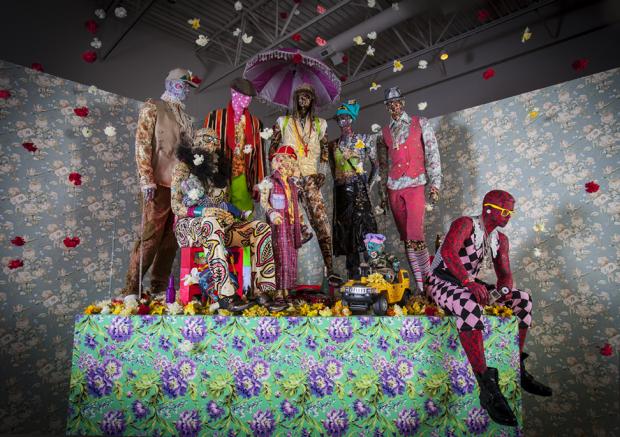Ebony G. Patterson at UB Center for the Arts
A dozen or so mixed media fabric and glitter and bling artworks by Ebony G. Patterson are currently on show at the UB Center for the Arts. Works said to explore a range of complex topics including “class, gender, and race,” with particular reference to Jamaican dancehall culture. Touching along the way on “images and reports of violent fatalities” as presented on social media.
Floor-display tapestries with sewn-on or glued-on elements, and items that may be placed on the base tapestry but not physically attached. Such as some toy trucks, a miniature soccer ball, miniature basketball, more or less regulation-size baseball, and on one piece, two pairs of shoes, an expensive-looking alligator and/or snake skin men’s pair, and stilt-heel women’s pair that look more like a torture device. The sewn-on or glued-on elements include various appliqué items, embroidery, knitted flowers—sometimes in pink, sometimes in black—and costume jewelry and gems. Oh, and glitter. Like it had snowed glitter.
Also one wall-hanging tapestry. And one large sculptural group of eight or ten fabric-skin manikins outfitted in outlandish costumes. Brocade trousers, plaids embellished with rhinestones, harlequin patterns, gold and silver chains. Jamaican dancehall costume, supposedly.
Challenging artwork. Requiring a distinction between seeing and looking, according to artist. “Seeing is what happens on social media,” she explains, “but looking is what I’m asking you to do. The looking requires thought, it requires engagement, it requires awareness, it requires inquiry, it requires patience.” (I would have thought just the opposite regarding looking and seeing, what they involve and require.)
But copious expository material—artist’s talk, curator talk—in wall copy and handout sheets. Such as on the reason for the glitter. A bee and flower explanation. “The bee is attracted to the flower because of its coloring, because of its beauty,” Patterson says, “and it isn’t until he [sic] gets in that he discovers if the flower has the nectar he wants. So you are attracted to the work because of its shininess, because of its prettiness, but it’s not until you get into the work that you start to realize that there’s something more.”
And on a connection to ongoing research by art historian Krista Thompson on the use of light in African diasporic cultures. After encountering Thompson’s work, Patterson says, “I started to see glitter for what it is. It is light, it is illumination. I was looking at a lot of party photos on different websites and thinking a lot about light. In this case…photo light and video light, and how the photo light becomes this way of giving visibility to people, and a chance for the ordinary person to shine.”
The manikins piece with outlandish costumes—entirely of men and boys—is said to explore “the body as a contested site regarding what is and isn’t masculine.” The matter of “metrosexuality.” (A word not in my desk dictionary, but Wikipedia has it in the substantive form “metrosexual.” As a combination of “metropolitan” and “sexual” to describe “a man—usually in an urban, post-industrial, capitalist culture—especially meticulous about his grooming and appearance, typically spending a significant amount of time and money on shopping” to achieve those ends. The Wikipedia entry adds that while the term is most often considered to refer to “heterosexual men who adopt fashions and lifestyles stereotypically associated with homosexual men,” it can also refer to gay or bisexual men.)
Further expository material points out that the artist was “inspired by images and reports of violent fatalities she sees circulated on social media,” and that she “creates…images of the deceased that seduce the viewer into bearing witness to the underreported and unacknowledged brutality experienced by those living on the lower rungs of the socioeconomic ladder.” Harder to see this murder violence exploration in the work. Or how it connects—if at all—with the main theme Jamaican dancehall culture. Or for that matter metrosexuality.
Lots of artist and curator talk, but not always cogent or compelling. Plus a bit as if to explain the work, rather than the work explaining itself. Nor any hint about the meaning of the show title, “Dead Treez,” in relation to the work
The Ebony G. Patterson exhibit continues through May 13.
Dead Treez
UB Art Galleries, North Campus,
Lower Art Gallery, 201 Center for the Arts, Room B45, Buffalo

